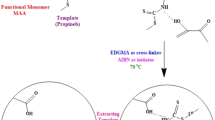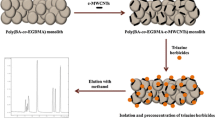Abstract
We report on an organic–inorganic hybrid material that was double imprinted with the insecticide carbaryl and the anti-inflammatory drug naproxen by a single-step method and that can serve for selective microextraction of the two analytes. The materials, in the form of monolithic columns, were characterized by scanning electron microscopy and Fourier transform IR spectra. A simple, rapid and sensitive method was then developed for the simultaneous determination of carbaryl and naproxen in lettuce and river water using these columns for microextraction, HPLC for separation, and a diode array for UV detection. The limits of detection (at S/N = 3) and quantification (at S/N = 10) are in the ranges of 2.5 – 8.8 μg kg−1 and 2.3 – 8.0 μg L−1 for lettuce and Yangtze River water, respectively. The recoveries of this method range from 93.0 to 108 % (in case of analyzing lettuce and river water), and relative standard deviations are <8.9 %.

An organic–inorganic hybrid carbaryl and naproxen imprinted monolithic column was synthesized, characterized and applied. The derivated double-template imprinted polymer showed high selectivity and enrichment ability for templates. It can be used as an alternative technique for extracting carbaryl and naproxen from complex samples.



Similar content being viewed by others
References
Hoshina K, Horiyama S, Matsunaga H, Haginaka J (2009) Molecularly imprinted polymers for simultaneous determination of antiepileptics in river water samples by liquid chromatography–tandem mass spectrometry. J Chromatogr A 1216:4957
Chen L, Zhang X, Xu Y, Du X, Sun X, Sun L, Wang H, Zhao Q, Yu A, Zhang H, Ding L (2010) Determination of fluoroquinolone antibiotics in environmental water samples based on magnetic molecularly imprinted polymer extraction followed by liquid chromatography–tandem mass spectrometry. Anal Chim Acta 662:31
Prieto A, Schrader S, Bauer C, Möder M (2011) Synthesis of a molecularly imprinted polymer and its application for microextraction by packed sorbent for the determination of fluoroquinolone related compounds in water. Anal Chim Acta 685:146
Li Y, Fu Q, Liu M, Jiao YY, Du W, Yu C, Liu J, Chang C, Lu J (2012) Separation and enrichment of trace ractopamine in biological samples by uniformly-sized molecularly imprinted polymers. J Pharm Anal 6(2):395
Lucci P, Núñez O, Galceran MT (2011) Solid-phase extraction using molecularly imprinted polymer for selective extraction of natural and synthetic estrogens from aqueous samples. J Chromatogr A 1218:4828
Beltran A, Borrull F, Cormack PAG, Marcé RM (2011) Molecularly imprinted polymer with high-fidelity binding sites for the selective extraction of barbiturates from human urine. J Chromatogr A 1218:4612
Shi XZ, Liu JH, Sun AL, Li DX, Chen J (2012) Group-selective enrichment and determination of pyrethroid insecticides in aquaculture seawater via molecularly imprinted solid phase extraction coupled with gas chromatography-electron capture detection. J Chromatogr A 1227(2):60
Muhammad T, Cui L, Jide W, Piletska EV, Guerreiro AR, Piletsky SA (2012) Rational design and synthesis of water-compatible molecularly imprinted polymers for selective solid phase extraction of amiodarone. Anal Chim Acta 709:98
Sreenivasan K, Sivakumar R (1999) Imparting recognition sites in poly (HEMA) for two compounds through molecular imprinting. J Appl Polym Sci 71:1823
Sreenivasan K (2001) Molecularly imprinted polyacrylic acid containing multiple recognition sites for steroids. J Appl Polym Sci 82:889
Dickert F, Achatz P, Halikias K (2001) Double molecular imprinting–a new sensor concept for improving selectivity in the detection of polycyclic aromatic hydrocarbons (PAHs) in water. Fresen J Anal Chem 371:11
Schweitz L, Andersson LI, Nilsson S (2002) Molecularly imprinted CEC sorbents: investigations into polymer preparation and electrolyte composition. Analyst 127:22
Suedee R, Srichana T, Chuchome T, Kongmark U (2004) Use of molecularly imprinted polymers from a mixture of tetracycline and its degradation products to produce affinity membranes for the removal of tetracycline from water. J Chromatogr B 811:191
LeJeune J, Spivak DA (2009) Analyte separation by OMNIMIPs imprinted with multiple templates. Biosens Bioelectron 25:604
Meng AC, LeJeune J, Spivak DA (2009) Multi-analyte imprinting capability of OMNIMIPs versus traditional molecularly imprinted polymers. J Mol Recognit 22:121
Song XL, Li JH, Xu SF, Ying RJ, Ma JP, Liao CY, Liu DY, Yu JB, Chen LX (2012) Determination of 16 polycyclic aromatic hydrocarbons in seawater using molecularly imprinted solid-phase extraction coupled with gas chromatography-mass spectyrometry. Talanta 99:75
Dai CM, Zhang J, Zhang YL, Zhou XF, Duan YP, Liu SG (2012) Selective removal of acidic pharmaceuticals from contaminated lake water using multi-templates molecularly imprinted polymer. Chem Eng J 211–212:302
Duan YP, Dai CM, Zhang YL, Chen L (2013) Selective trace enrichment of acidic pharmaceuticals in real water and sediment samples based on solid-phase extraction using multi-templates molecularly imprinted polymers. Anal Chim Acta 758:93
Blanco SGD, Donato L, Drioli E (2012) Development of molecularly imprinted membranes for selective recognition of primary amines in organic medium. Sep Purif Technol 87:40
Li XX, Bai LH, Wang H, Wang J, Huang YP, Liu ZS (2012) Preparation and characterization of enrofloxacin-imprinted monolithic column prepared with crowding agents. J Chromatogr A 1251:141
Tsai HA, Syu MJ (2011) Preparation of imprinted poly(tetraethoxysilanol) sol–gel for the specific uptake of creatinine. Chem Eng J 168:1369
Xu WZ, Zhou W, Xu PP, Pan JM, Wu XY, Yan YS (2011) A molecularly imprinted polymer based on TiO2 as a sacrificial support for selective recognition of dibenzothiophene. Chem Eng J 172:191
Jiang ZT, Yu YX, Wu H (2006) Preparation of CS/GPTMS hybrid molecularly imprinted membrane for efficient chiral resolution of phenylalanine isomers. J Membr Sci 280:876
Jiang GS, Zhong SA, Chen L, Blakey I (2011) A Whitaker, Synthesis of molecularly imprinted organic–inorganic hybrid azobenzene materials by sol–gel for radiation induced selective recognition of 2,4-dichlorophenoxyacetic acid. Radiat Phys Chem 80:130
Wu H, Zhao YY, Nie MC, Jiang ZY (2009) Molecularly imrinted organic–inorganic hybrid membrances for selective separation of phenylalanine isomers and its analogue. Sep Purif Technol 68:97
He JX, Fang GZ, Deng QL, Wang S (2011) Preparation, characterization and application of organic–inorganic hybrid ractopamine multi-template molecularly imprinted capillary monolithic columnic column. Anal Chim Acta 692:57
Lv YK, Wang LM, Yang L, Zhao CX, Sun HW (2012) Synthesis and application of molecularly imprinted poly(methacrylic acid)-silica hybrid composite material for selective solid-phase extraction and high-performance liquid chromatography determination of oxytetracycline residues in milk. J Chromatogr A 1227:48
Zhou JF, Ma C, Zhou S, Ma PL, Chen FR, Qi Y, Chen HX (2010) Preparation, evaluation and application of molecularly imprinted solid-phase microextraction monolithic column for selective extraction of pirimicarb in tomato and pear. J Chromatogr A 1217:7478
Tan J, Jiang ZT, Li R, Yan XP (2012) Molecularly-imprinted monolithic columns for sample treatment and separation. Trends Anal Chem 39:207
Sun N, Wu SL, Chen HX, Zheng DJ, Xu JW, Ye Y (2012) Determination of sulfamethoxazole in milk using molecularly imprinted polymer monolith. Microchim Acta 179:33
Liu L, Zuo M, Cheng J, Matsadiq G, Zhou HB, Li JK (2012) Coupling polymer monolith microextraction to gas chromatography: determination of pyrethroids in water samples. Microchim Acta 173:127
Lin Z, Yang F, He XW, Zhao XM, Zhang YK (2009) Preparation and evaluation of a macroporous molevularly imprinted hybrid silica monolithic columnic column for recognition of proteins by high performance liquid chromatography. J Chromatogr A 1216:8612
Ni YN, Xiao WQ, Kokot S (2009) Application of chemometrics methods for the simultaneous kinetic spectrophotometric determination of aminocarb and carbaryl in vegetable and water samples. J Hazard Mater 168:1239
Huertas-Pérez JF, García-Campan AM (2008) Determination of N-methylcarbamate pesticides in water and vegetable samples by HPLC with post-column chemiluminescence detection using the luminol reaction. Anal Chim Acta 630:194
Totti S, Fernández M, Ghini S, Picó Y, Fini F, Maňes J, Girotti S (2006) Application of matrix solid phase dispersion to the determination of imidacloprid, carbaryl, aldicarb, and their main metabolites in honeybees by liquid chromatography–mass spectrometry detection. Talanta 69:724
Acknowledgments
This work was supported by the Natural Science Fund for Creative Research Groups of Hubei Province of China (grant no. 2011CDA111), and the Education Commission of Hubei Province of China (grant no. T201101, D20120106), the National Nature Science Foundation of China (grant no. 20975030, 21003034). The authors would like to thank their colleagues for their valuable technical assistance.
Author information
Authors and Affiliations
Corresponding authors
Electronic supplementary material
Below is the link to the electronic supplementary material.
ESM 1
(DOC 136 kb)
Rights and permissions
About this article
Cite this article
Zhang, T., Ma, C., Wu, M. et al. Selective microextraction of carbaryl and naproxen using organic–inorganic monolithic columns containing a double molecular imprint. Microchim Acta 180, 695–702 (2013). https://doi.org/10.1007/s00604-013-0990-y
Received:
Accepted:
Published:
Issue Date:
DOI: https://doi.org/10.1007/s00604-013-0990-y




